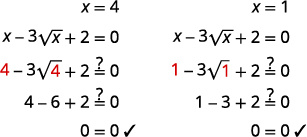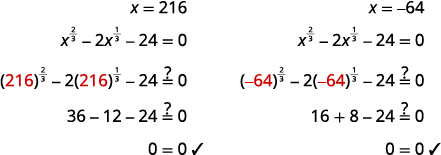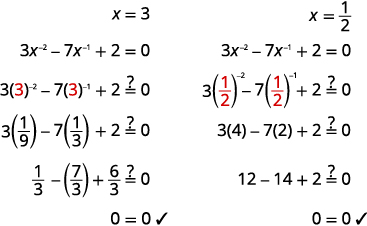9.5: Solve Quadratic Equations in Quadratic Form
( \newcommand{\kernel}{\mathrm{null}\,}\)
By the end of this section, you will be able to:
- Solve equations in quadratic form
... take this readiness quiz.
- Factor by substitution: y4−y2−20.
- Factor by substitution: (y−4)2+8(y−4)+15.
- Simplify
- x12⋅x14
- (x13)2
- (x−1)2
Solve Equations in Quadratic Form
Sometimes when we factored trinomials, the trinomial did not appear to be in the ax2+bx+c form. So we factored by substitution allowing us to make it fit the ax2+bx+c form. We used the standard u for the substitution.
To factor the expression x4−4x2−5, we noticed the variable part of the middle term is x2 and its square, x4, is the variable part of the first term. (We know (x2)2=x4.) So we let u=x2 and factored.
| x4−4x2−5 | |
| (x2)2−4(x2)−5 | |
| Let u=x2 and substitute. | u2−4u−5 |
| Factor the trinomial. | (u+1)(u−5) |
| Replace u with x2. | (x2+1)(x2−5) |
Similarly, sometimes an equation is not in the ax2+bx+c=0 form but looks much like a quadratic equation. Then, we can often make a thoughtful substitution that will allow us to make it fit the ax2+bx+c=0 form. If we can make it fit the form, we can then use all of our methods to solve quadratic equations.
Notice that in the quadratic equation ax2+bx+c=0, the middle term has a variable, x, and its square, x2, is the variable part of the first term. Look for this relationship as you try to find a substitution.
Again, we will use the standard u to make a substitution that will put the equation in quadratic form. If the substitution gives us an equation of the form ax2+bx+c=0, we say the original equation was of quadratic form.
The next example shows the steps for solving an equation in quadratic form.
Solve: 6x4−7x2+2=0
Solution:
| Step 1: Identify a substitution that will put the equation in quadratic form. | Since (x2)2=x4, we let u=x2. | 6x4−7x2+2=0 |
| Step 2: Rewrite the equation with the substitution to put it in quadratic form. |
Rewrite to prepare for the substitution. Substitute u=x2. |
6(x2)2−7x2+2=06u2−7u+2=0 |
| Step 3: Solve the quadratic equation for u. |
We can solve by factoring. Use the Zero Product Property. |
(2u−1)(3u−2)=02u−1=0,3u−2=02u=1,3u=2u=12u=23 |
| Step 4: Substitute the original variable back into the results, using the substitution. | Replace u with x2. | x2=12x2=23 |
| Step 5: Solve for the original variable. | Solve for x, using the Square Root Property. |
x=±√12x=±√23x=±√22x=±√63 There are four solutions. x=√22x=√63x=−√22x=−√63 |
| Step 6: Check the solutions. | Check all four solutions. We will show one check here. |
x=√226x4−7x2+2=06(√22)4−7(√22)2+2?=06(416)−7(24)2+2?=032−72+42?=00=0 We leave the other checks to you! |
Solve: x4−6x2+8=0.
- Answer
-
x=√2,x=−√2,x=2,x=−2
Solve: x4−11x2+28=0.
- Answer
-
x=√7,x=−√7,x=2,x=−2
We summarize the steps to solve an equation in quadratic form.
- Identify a substitution that will put the equation in quadratic form.
- Rewrite the equation with the substitution to put it in quadratic form.
- Solve the quadratic equation for u.
- Substitute the original variable back into the results, using the substitution.
- Solve for the original variable.
- Check the solutions.
In the next example, the binomial in the middle term, (x−2) is squared in the first term. If we let u=x−2 and substitute, our trinomial will be in ax2+bx+c form.
Solve: (x−2)2+7(x−2)+12=0.
Solution:
| (x−2)2+7(x−2)+12=0 | |
| Prepare for the substitution. | (x−2)2+7(x−2)+12=0 |
| Let u=x−2 and substitute. | u2+7u+12=0 |
| Solve by factoring. |
(u+3)(u+4)=0 u+3=0,u+4=0u=−3,u=−4 |
|
Replace u with x−2. |
x−2=−3,x−2=−4 |
|
Solve for x. |
x=−1,x=−2 |
|
Check: 
|
Solve: (x−5)2+6(x−5)+8=0.
- Answer
-
x=3,x=1
Solve: (y−4)2+8(y−4)+15=0.
- Answer
-
y=−1,y=1
In the next example, we notice that (√x)2=x. Also, remember that when we square both sides of an equation, we may introduce extraneous roots. Be sure to check your answers!
Solve: x−3√x+2=0.
Solution:
The √x in the middle term, is squared in the first term (√x)2=x. If we let u=√x and substitute, our trinomial will be in ax2+bx+c=0 form.
| x−3√x+2=0 | |
| Rewrite the trinomial to prepare for the substitution. |  |
| Let u=√x and substitute. |  |
| Solve by factoring. |
(u−2)(u−1)=0 u−2=0,u−1=0 |
| Replace u with √x. |
√x=2,√x=1 |
| Solve for x, by squaring both sides. | x=4,x=1 |
|
Check:  |
Solve: x−7√x+12=0.
- Answer
-
x=9,x=16
Solve: x−6√x+8=0.
- Answer
-
x=4,x=16
Substitutions for rational exponents can also help us solve an equation in quadratic form. Think of the properties of exponents as you begin the next example.
Solve: x23−2x13−24=0.
Solution:
The x13 in the middle term is squared in the first term (x13)2=x23. If we let u=x13 and substitute, our trinomial will be in ax2+bx+c=0 form.
| x23−2x13−24=0 | |
| Rewrite the trinomial to prepare for the substitution. |  |
| Let u=x13 |  |
| Solve by factoring. |
(u−6)(u+4)=0 u−6=0,u+4=0 u=6,u=−4 |
| Replace u with x13. |
x13=6,x13=−4 |
| Solve for x by cubing both sides. |
(x13)3=(6)3,(x13)3=(−4)3 x=216,x=−64 |
|
Check: 
|
Solve: x23−5x13−14=0.
- Answer
-
x=−8,x=343
Solve: x12+8x14+15=0.
- Answer
-
x=81,x=625
In the next example, we need to keep in mind the definition of a negative exponent as well as the properties of exponents.
Solve: 3x−2−7x−1+2=0.
Solution:
The x−1 in the middle term is squared in the first term (x−1)2=x−2. If we let u=x−1 and substitute, our trinomial will be in ax2+bx+c=0 form.
| 3x−2−7x−1+2=0 | |
| Rewrite the trinomial to prepare for the substitution. |  |
| Let u=x−1 and substitute. |  |
| Solve by factoring. | (3u−1)(u−2)=0 |
| 3u−1=0,u−2=0 | |
| u=13,u=2 | |
| Replace u with x−1. | x−1=13,x−1=2 |
| Solve for x by taking the reciprocal since x−1=1x. | x=3,x=12 |
|
Check: 
|
Solve: 8x−2−10x−1+3=0.
- Answer
-
x=43,x=2
Solve: 6x−2−23x−1+20=0.
- Answer
-
x=25,x=34
Access this online video for additional instruction and practice with solving quadratic equations: https://www.youtube.com/watch?v=7X-CZMbpxuw
Key Concepts
- How to solve equations in quadratic form.
- Identify a substitution that will put the equation in quadratic form.
- Rewrite the equation with the substitution to put it in quadratic form.
- Solve the quadratic equation for u.
- Substitute the original variable back into the results, using the substitution.
- Solve for the original variable.
- Check the solutions.


